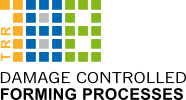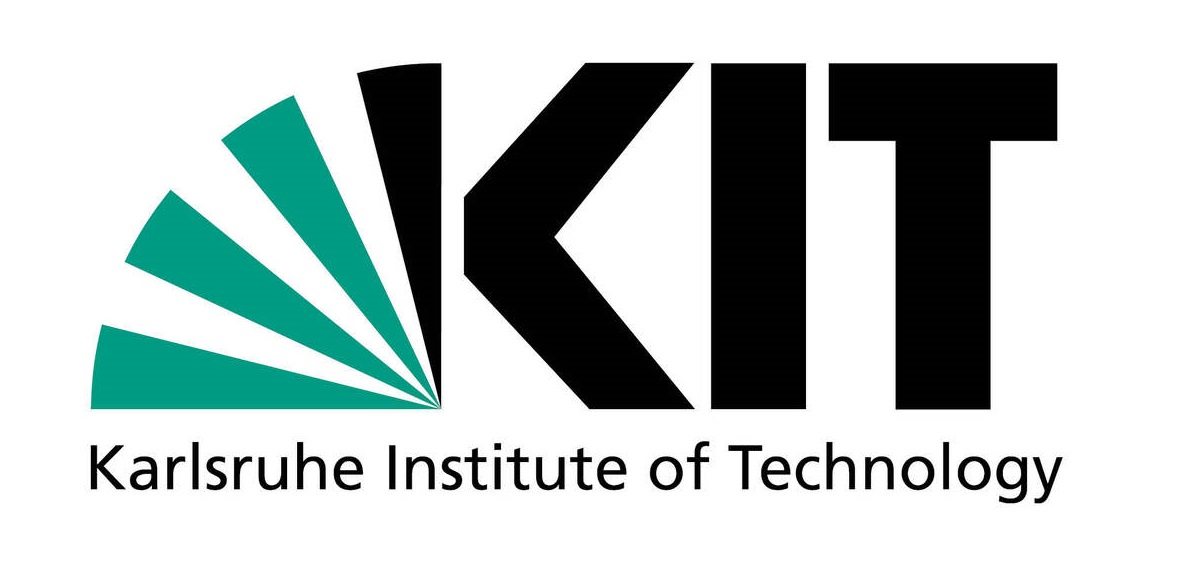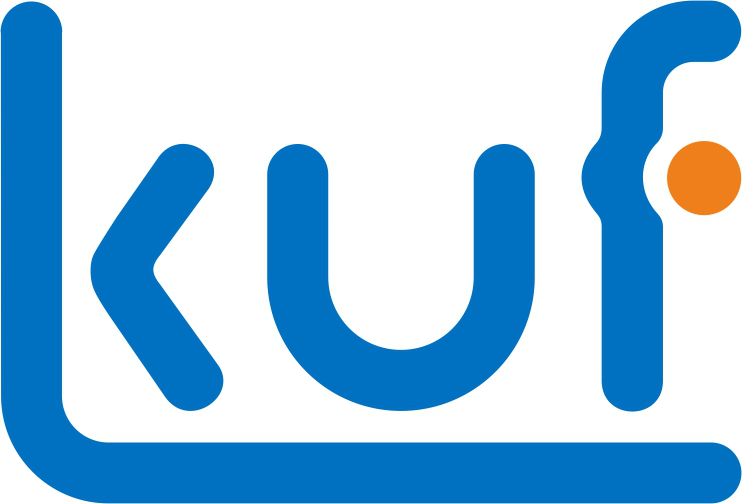Summary
In the first and second funding period of the TRR 188, proof was provided that the damage induced by the forming process influences the performance of DP800 and 16MnCrS6 steels. However, these investigations have so far only been carried out on basic samples and have not focused on the performance of real components. The overall objective of the project A09 is therefore the fundamental scientific investigation of the influence of forming-induced damage on the scatter of the performance of components produced by forming processes. The specific focus on scatter is due to the fact that these investigations can subsequently be integrated into probabilistic safety concepts, in which forming-induced damage has not yet been taken into account quantitatively under consideration of damage-controlled forming processes. The demonstrator used is an airbag pressure bin produced by project A02 by impact extrusion with controlled damage by adjusting the process parameters. The criterion used to evaluate the performance of the component is the ultimate load of the airbag pressure bin, which is the burst pressure.
The quantification of the scatter in burst pressure by project A09 is carried out in a two-stage procedure consisting of simulations and experiments. In a first step, a simulation model of the airbag pressure bins is developed and calibrated. A newly acquired testing machine then enables testing of the airbag pressure bins under internal pressure and thus the validation of the simulation model. Geometric imperfections, which also contribute to the scatter of the performance, must be taken into account in the simulation model, while the material model used is extended to include the effects of the initial damage state of the airbag pressure bin induced by the forming process. As a failure criterion, the limit strain concept is used, which is further developed to map the limit strains as a function of the initial damage state. This concept is calibrated experimentally by taking secondary samples from extruded components with known damage states and recording the limit strains using tensile tests with a defined stress state. Since only one geometry for the airbag pressure bin under internal pressure is considered in project A09, a constant stress state is assumed in the development of the limit strain concept.
In the second step, a numerical parameter study is performed using the validated model to quantify the damage-based scatter of the performance of the airbag pressure bin. This quantification is carried out using Monte Carlo simulation (MCS), which enables the scatter of damage to be propagated to the ultimate load. Since the MCS requires a high number of numerical evaluations of the ultimate load in dependence of the uncertain damage, an efficient, structural modelling of the airbag pressure bin, for example with shell elements, is intended in combination with suitable surrogate modelling techniques, e.g., Gaussian process regression.
Project A09 provides a numerical simulation methodology for the inclusion of the influence of forming-induced damage in the determination of the component performance. This closes a fundamental knowledge gap in the context of the TRR 188, as the knowledge gained on damage can subsequently be used for optimal component design considering the forming-induced damage within the framework of probabilistic safety concepts.
To achieve the project goals, a pronounced cooperation with project A02 and project C06 is intended: project A09 is connected to project A02 and evaluates the performance of the airbag pressure bins produced by impact extrusion. The quantification of the scatter takes place in cooperation with project C06, which provides efficient probabilistic methods and surrogate models. Project A09 is also a part of the of projects evaluating the performance of formed components in various ways. In addition to resistance to bursting pressure, projects B01 and B05 evaluate the cyclic performance of components and B01 also evaluates the behavior under high-speed loading.
Current state of research and preliminary work
Influence of damage on the product properties
Complex load paths during forming inevitably affect the mechanical properties and the subsequent product properties of the final components [Tek17, Sch85]. This is influenced by the resulting hardening, residual stresses, and damage, where the separation of individual influencing factors is not always straightforward [Lem87]. In the cold rolling of DP800, varying the pass reduction leads to a reduction in damage (measured by density and SEM) and alters the energy absorption in the impact tensile test. However, due to concurrently altered hardening, the test’s energy absorption cannot undoubtedly correlate with damage [Feh23].
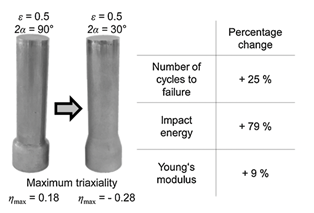 |
|
Fig. 1: Forming-induced damage by variation of the extrusion angle alters significant mechanical properties. [Her20] |
To prove the effects of forming- or process-induced damage, it is essential to demonstrate that other influencing factors such as residual stresses and hardening remain constant through varying process parameters. Extensive investigations have already been conducted within the framework of the TRR 188 to achieve this. For the full-forward extrusion process, [Her20] demonstrated that varying the shoulder opening angle influences damage, while the hardening remains constant in the region of the (secondary) sample extraction, and residual stresses can be reduced to a negligible level through the sample fabrication process. It was thus shown that there is an isolated effect of damage on multiple product properties, such as fatigue life, impact toughness, and Young’s modulus, which is shown in Fig 1. Similar effects can also be observed in the bending of thin sheets [Mey19a]. Applied pressure superposition during the bending leads to reduced damage and increased energy absorption in the (modified) Charpy impact test. In all three described cases, the key control variable is the altered stress triaxiality resulting from the process variation. Compressive loading reduces the stress triaxiality, consequently inhibiting the nucleation and growth of new voids, which also impacts mechanical properties and failure in basic tests [Pen09, Bro83]. These studies have also revealed a scattering in the forming-induced damage and the resulting properties [Her20, Mey19b]. However, it remains unclear whether the scatter can be quantitatively reduced by damage-controlled forming.
Considering that the damage incurred during the manufacturing process affects product properties, the predictive quality of simulation models can be enhanced by incorporating the manufacturing-induced damage [Bou08]. This involves constructing multi-stage simulation models, initially simulating the manufacturing process, then mapping the resulting material states (damage, hardening etc.) onto a model of the application case, and finally simulating the application case. This approach may also include the transfer from two-dimensional to three-dimensional models and between different program codes [Gac15]. Through such simulation concepts, the predictive quality of relevant final mechanical product properties can be distinctly improved, as demonstrated for self-piercing riveting joints and the resulting mechanical strength [Fay14]. For clinching, a global simulation approach has demonstrated that mechanical strength can be enhanced under both tensile and shear loads when manufacturing-induced damage is controlled, using a two-stage optimisation approach [Rou13].
Reliability analysis
The level of safety of a system in terms of a failure probability can be quantified using probability theory, although the calculation of the failure probability for practical cases is a challenging task [Val23]. Traditionally, in component design safety factors are defined which, depending on the consequences of the failure of a structure, regulate the probability of the occurrence of structural failure. For a more detailed approach, it is possible to further subdivide the safety factor into several partial safety factors. Here, a partial safety factor is defined for each variable having an influence on the structure failure [Mel17].
Uncertainties or scatter of these influence variables are described in the form of probability density functions. In the component design, these uncertainties of the influencing variables are traditionally taken into account by deterministic, conservative, characteristic values. The characteristic values of the variables are determined in dependence of the probability density functions but are subsequently assumed to be constant [Mel17]. For reference, according to [EN1990], the 5% quantiles of the probability density function are defined for the characteristic values of the material properties that are subject to uncertainty and have a high sensitivity with respect to the ultimate load.
As in the traditional approach the information regarding the scatter of the influencing variables is lost, methods are developed in probability theory that enable the propagation of uncertainties of the influencing variables in the calculation of the ultimate load of components based on the probability density functions. One of these methods is the Monte Carlo simulation (MCS). Since theoretically, the MCS converges to the correct result only for an infinite number of numerical evaluations, surrogate modelling (e.g., Gaussian process regression) is used to achieve a higher rate of convergence and thus reduce the required computational costs [Dan23, Böd23].
The results obtained in the first two funding periods of the TRR 188 have confirmed that the forming-induced damage can be quantified in terms of void volume and that this has an influence on the material properties [Her20, Tek17]. Nevertheless, a scatter of the quantitative forming-induced damage is observed in geometrically identical components that are manufactured on the same process route while maintaining identical process parameters. Since this scatter of the damage also induces a scatter of the material properties and thus of the ultimate load of the components, a quantification of this influence based on probability theory is essential to evaluate the failure probability of a component depending on the forming-induced damage.
Preliminary research
Project leader Sebastian Münstermann (SM) possesses extensive expertise and preliminary work in the realm of damage mechanics simulation and modeling of diverse steel grades. A focal point has been the distinct damage behavior, its numerical characterisation, and its influence on mechanical properties. Through a comparative study of two distinct DP steel grades, DP800 and DP1000 [*Püt20], using a combined experimental and numerical approach, it was demonstrated that the pronounced scatter in ultimate elongation in DP800 can be attributed to the heterogeneous martensite bands. Furthermore, the phase of damage accumulation in DP800 during various tensile tests is markedly more pronounced than in DP1000, despite a comparable strain at damage initiation.
Utilizing comparable methods, the differences in mechanical properties between Medium-Manganese steels (MMnS) and dual-phase steels can also be clarified [*She21]. In this context, it becomes evident that distinguishing between local and global formability is essential to accurately describe relevant product properties. Through damage mechanics modeling approaches, it has been demonstrated that despite the significantly higher global formability of MMnS, DP1000 exhibits a superior local formability, which holds particular significance for susceptibility to edge cracking [*She21].
For the damage mechanics simulations, SM employed the modified Bai-Wierzbicki model [Bai08, Lia12], which is capable of accounting for the effects of temperature [She22] and strain rate [Hab22] in addition to the stress state influence. This enables the simulation of various forming processes and component service conditions.
As already delineated in the state of the art, the incorporation of manufacturing-related variables into (multi-stage) simulation processes can enhance the prediction of mechanical properties. SM was able to demonstrate this using the example of the hole expansion test. Through a two-stage simulation (punching followed by hole expansion tests) and the consideration of damage and surface irregularities, the prediction quality of the Hole Expansion Ratio (HER) was improved, allowing for an investigation of the influence of the manufacturing process on the final product properties [*Hab19]. Fig. 2 shows the 2-stage simulation concept for punching and hole expansion tests.
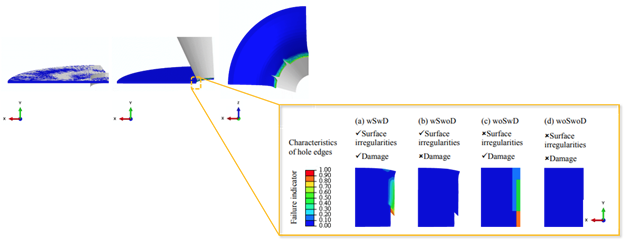 |
| Fig. 2: 2-stage simulation concept for punching and hole expansion test (top) – different conditions of the surface of the hole (bottom) – (wS: with Surface, consideration of surface properties, wD: with Damage, consideration of damage from the punching process) (figure adapted from [Hab19]) |
Such a simulation concept enables the incorporation of manufacturing-induced damage into component deployment or component testing. A similar approach was pursued in [*Wec21], where multiscale damage-mechanical simulations were employed to account for the influences of surface roughness in the hole expansion test. As a result, the HER prediction changes from 73% to 61.9%, presenting an approximation to the experimental value of 48.6%. Furthermore, multiscale simulations have already been employed by the applicant Münstermann for the damage-mechanical modelling of unheated pressure vessels [*Bri20]. These insights are intended to be utilized in this project as well.
The investigations planned for project A09 also necessitate a simulation concept capable of depicting the scatter of deformation-induced damage and translating it into varying mechanical properties. One approach is to represent this by scattering parameters of a suitable damage-mechanical model (alternatively, the direct consideration of pre-damage as a variable in the model is also possible). Fig. 3 illustrates an exemplary procedure for incorporating deformation-induced damage using a Lemaitre-type model. In a first step a.), instrumented notched Charpy impact bending tests were conducted using samples taken from various full-forward extruded specimens of project A02. By adjusting the stress state-dependent failure parameters of the model in step b.), maximum and minimum energy absorption could be reproduced with good accuracy (cf. step c.)). This demonstrated the fundamental possibility of modelling the scattering material properties through scattered deformation-induced damage. However, the results shown here are not generally applicable, as, on the one hand, the specific stress state of a component under consideration was not taken into account. On the other hand, the considered damage states are not readily transferable to components.
The project leader Kai-Uwe Schröder (KSC) has accumulated many years of expertise in the field of digitalisation, modelling, and optimisation of thin-walled lightweight structures. In the framework of modelling thin-walled structures using shell elements, the project leader KSC systematically integrated the manufacturing-related imperfections, which represent a further uncertainty in the component design, into the design of shell structures. Here, locally varying geometric imperfections were considered in the form of deviations of both the radius of the shell mid-surface and the thickness of the shell from the respective nominal values. Based on numerical investigations, the effects of the imperfections on the ultimate load of the shell were quantified. Since the imperfections of shell structures are dependent on the manufacturing process, a correlation between the manufacturing process and the ultimate load of shell structures was determined in a subsequent step [*Lys20]. Since the quantification of the scatter of the ultimate load of the airbag pressure bin in dependence of the forming-induced damage is a central aspect of this project, further uncertainties, e.g. manufacturing-related imperfections, have to be considered to determine the true impact of the forming-induced damage. For the modelling of shell structures with locally varying material properties, finite element formulations for shell elements with graded materials have been formulated by KSC. These shell elements utilize theories of higher order for various coupled multi-physics problems employing layer-wise approaches to vary the material properties in the thickness direction [*Mek18].
In his research in the field of structural health monitoring, KSC used a Bayesian model updating approach to increase the accuracy of damage detection and solve the due to limited measurements ill-conditioned problem [*Hua20]. Additionally, in [*Hua20] an efficient perturbation-based surrogate model for beam and shell structures was developed to reduce the computationally expensive model in the Bayesian framework.
The project leaders KSC and SM have worked together to demonstrate the potential of utilizing locally varying material properties to increase component performance, using the energy absorption capability of a crash box as an example [*Agh21]. By these means, the project leaders have shown their expertise on the utilisation of locally varying material properties, to which the forming-induced damage also belongs.
 |
| Fig. 3: Simulation concept for mapping scattering material properties through scattering damage parameters: Step a.): Carrying out experimental tests, step b.): Adaptation of the failure parameters of the damage models, step c.): Mapping the test results from minimum to maximum |
Conclusion
In summary, previous fundamental scientific investigations have demonstrated that the influence of forming- or manufacturing-induced damage on final product properties can be substantiated both experimentally and through simulation. However, a systematic examination and quantification of the impact of damage controlled forming on the scatter of the resulting damage states and the subsequent variations in the mechanical properties and performance measures, is still missing. Project A09 aims to close this knowledge gap by developing an approach to quantify the scatter of damage and the influence on the performance of a component. These investigations can subsequently be used to take forming-induced damage into account in the framework of probabilistic safety concepts.
Project- and subject-related list of publications
|
[*Agh21] |
Aghdam N, Sparrer Y, Zimmermann J, Mäde K, Sharma R, Reisgen U, Schröder K-U, Münstermann S, 2021. Potential of inverted process-chain development to improve crash box performance. Metals, 13(5), 915; DOI: https://doi.org/10.31224/osf.io/buv46 |
|
[*Brin20] |
Brinnel V., Schaffrath S., Münstermann S., Feldmann M, 2020. Efficient, scale-bridging simulation of ductile failure in a burst test using damage mechanics, Int. J. Pressure Vessels and Piping, 188, 104242 DOI: https://doi.org/10.1016/j.ijpvp.2020.104242 |
|
[*Hab20] |
Habibi N., Baier T., Richter H., Könemann M., Münstermann S, 2019. The effects of shear affected zone on edge crack sensitivity in dual-phase steels, 9 IOP Conf. Ser.: Mater. Sci. Eng, 651, 012073 DOI:10.1088/1757-899X/651/1/012073 |
|
[*Hua20] |
Huang T, Schröder K-U, Schagerl M, 2020. Bayesian probabilistic damage identification using responses at vibration nodes. Doctoral thesis, Institute of structural mechanics and lightweight design, RWTH Aachen. DOI: https://doi.org/10.1016/j.ymssp.2020.106998 |
|
[*Lys20] |
Lyssakow P, Yang J, Krause M, Schröder K-U, 2020. Towards a manufacturing signature for unstiffened flow formed thin-walled shell structures. Thin-Walled Struct., 155, 106933. |
|
[*Mek18] |
Mekala RN, Schmidt R, Schröder K-U, 2018. Static and dynamic FE analysis of piezolaminated composite shells considering electric field nonlinearity under thermos-electro-mechanical loads. Acta Mech., 229, 5093-5120. DOI: https://doi.org/10.1007/s00707-018-2284-2 |
|
[*Püt20] |
Pütz, F., Shen, F., Könemann, M., Münstermann, S., 2020. The differences of damage initiation and accumulation of DP steels: a numerical and experimental analysis. Int. J. Frac. 226, pp. 1-15, DOI: https://doi.org/article/10.1007/s10704-020-00457-z |
|
[*She21] |
Shen F., Wang H., Xu H., Liu W., Münstermann S., Lian J. 2022 Local Formability of Different Advanced High Strength steels, Key engineering materials, 926, pp.917-925, |
|
[*Wec21] |
Wechsuwanmanee P., Lian J., Münstermann S. 2021 3D multilevel Modeling of Surface roughness Influences on Hole Expansion ratios, steel res. Int., 92(12), 2100449, |
Literature cited in the text:
|
[Bai08] |
Bai, Y., Wierzbicki, T., 2008. A new model of metal plasticity and fracture with pressure and Lode dependence, Int. J. Plas. 24(6) pp. 1071-1096 DOI: https://doi.org/10.1016/j.ijplas.2007.09.004 |
|
[Bou08] |
P.O. Bouchard, T. Laurent, L. Tollier, 2008. Numerical modeling of self-pierce riveting—From riveting process modeling down to structural analysis, Int. J. Mat. Proc. Tech. 202, pp. 290-300, DOI: https://doi.org/10.1016/j.jmatprotec.2007.08.077 |
|
[Bro83] |
A.Brownrigg, W.A. Spitzig, O. Richmond, D. Teirlinck, J.D. Embury, 1983. The influence of hydrostatic pressure on the flow stress and ductility of a spherodized 1045 steel Acta Metallurgica, 31(8), pp. 1141-1150, DOI: https://doi.org/10.1016/0001-6160(83)90176-1 |
|
[Dan23] |
Dang C, Valdebenito M, Faes M, Song J, Wei P, Beer M, 2023. Structural reliability analysis by sampling: A Bayesian active learning treatment. Structural Safety, 104, 102351, DOI: https://doi.org/10.1016/j.strusafe.2023.102351 |
|
[EN1990] |
DIN EN 1990: Eurocode: Basis of structural design. Apr 2002 |
|
[Fay14] |
Fayolle S, Bouchard P-O, Mocellin K, 2014. Modelling the Strength of Self-Piercing Riveted Joints. Self-Piercing Riveting, Elsevier, 79–107, DOI: https://doi.org/10.1533/9780857098849.1.79 |
|
[Feh24] |
Fehlemann, N., Czempas, C., Könemann, M., Lenz, D., Hirt, G., Münstermann, S., 2024. Investigation of Damage-Controlling Process-Parameters During Cold Rolling on the Impact Toughness of DP800 Steel Under Crash Loading Stress States, Proceedings of the 14th International Conference on the Technology of Plasticity - Current Trends in the Technology of Plasticity, pp. 232-242, DOI: 10.1007/978-3-031-42093-1_23 |
|
[Gac15] |
Gachet J-M, Delattre G, Bouchard P-O, 2015. Improved Fracture Criterion To Chain Forming Stage And In Use Mechanical Strength Computations Of Metallic Parts - Application To Half-Blanked Components. Journal of Materials Processing Technology 216:260–277, DOI: https://doi.org/10.1016/j.jmatprotec.2014.09.006 |
|
[Hab22] |
Franzen, D., Habibi, N., Könemann, M., Münstermann, S., Bührig-Polaczek, A., 2022. Strain rate sensitivity and toughness behavior of ductile iron under specific loading, materials Science and Technology, 39(2), pp.236-247, DOI:10.1080/02670836.2022.2110339 |
|
[Her20] |
Hering O, Tekkaya AE, 2020. Damage-Induced Performance Variations Of Cold Forged Parts. Journal of Materials Processing Technology 279:116556, DOI: https://doi.org/10.1016/j.jmatprotec.2019.116556 |
|
[Lem87] |
Lemaitre J, Dufailly J, 1987. Damage Measurements. Engineering Fracture Mechanics 28/5 6:643–661, DOI: https://doi.org/10.1016/0013-7944(87)90059-2 |
|
[Lia12] |
Lian, J., Sharaf, M., Archie, F., Münstermann, S., 2012. A hybrid modelling of plasticity and failure behavior of advanced high strength steel sheets, Int. J. Damage Mech. 22(2), pp. 118-218, doi: https://doi.org/10.1177/1056789512439319 |
|
[Mel17] |
Melchers RE, Beck AT, 2017. Structural Reliability Analysis and Prediction. John Wiley & Sons Ltd. DOI: https://doi.org/10.1002/9781119266105 |
|
[Mey19a] |
Meya R, Löbbe C, Tekkaya AE, 2019. Stress State Control by A Novel Bending Process And Its Effect On Damage And Product Performance. Journal of Manufacturing Science and Engineering 141/10. DOI: https://doi.org/ 10.1115/1.4044394 |
|
[Mey19b] |
Meya R, Kusche, C., Löbbe, C., Al-Samman, T., Korte-Kerzel, S., 2019. Global and high-resolution damage quantification in dual-phase steel bending samples with varying stress state. Metals 9(3), 319, DOI: https://doi.org/10.3390/met9030319 |
|
[Pen09] |
Peng, J., Wu, P.D., Huang, Y., Chen, X.X., Lloyd, D.J., Embury, J.D., Neale, K.W., 2009. Effects of superimposed hydrostatic pressure on fracture in round bars under tension Int. J. Solids Struct. 46, 3741–3749.DOI: https://doi.org/10.1016/j.ijsolstr.2009.07.001 |
|
[Rou13] |
Roux E, Bouchard P-O, 2013. Kriging Metamodel Global Optimization Of Clinching Joining Processes Accounting For Ductile Damage. Journal of Materials Processing Technology 213/7:1038–1047. DOI: https://doi.org/10.1016/j.jmatprotec.2013.01.018 |
|
[Sch85] |
Schwab, W., Lange, K., 1985. Effect of process parameters in metal forming on fatigue behavior. Ann. CIRP1985, 34, 215–219. DOI: https://doi.org/10.1016/S0007-8506(07)61759-4 |
|
[She22] |
Shen, F., Münstermann, S., Lian, J., 2022. A unified fracture criterion considering stress state dependent transition of failure mechanisms in bcc steels at -196°C, Int. J. Plas, 156, 103365, DOI: https://doi.org/10.1016/j.ijplas.2022.103365 |
|
[Tek17] |
Tekkaya AE, Ben Khalifa N, Hering O, Meya R, Myslicki S, Walther F, 2017. Forming-Induced Damage and Its Effects On Product Properties. CIRP Annals -– Manufacturing Technology 66/1:281–284. DOI: https://doi.org/10.1016/j.cirp.2017.04.113 |
|
[Val23] |
Valdebenito M, Yuan X, Faes M, 2023. Augmented First-Order Reliability Method for Estimating Fuzzy Failure Probabilities. Structural Safety, 105, 102380. DOI: https://doi.org/10.1016/j.strusafe.2023.102380 |
|
[Böd23] |
Böddecker, M., Faes, M., Menzel, A., Valdebenito, M., 2023.Effect of uncertainty of material parameters on stress triaxiality and Lode angle in finite elasto-plasticity - a variance-based global sensitivity analysis. Advances in Industrial and Manufacturing Engineering. Volume 7, November 2023, 100128. DOI: https://doi.org/10.1016/j.aime.2023.100128 |
